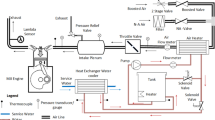Abstract
This article reports the experimental and theoretical results for a spark ignition engine working with compressed natural gas as a fuel. The theoretical part of this work uses a zero-dimensional, multi-zone combustion model in order to predict nitric oxide (NO) emission in a spark ignition (SI) engine. The basic concept of the model is the division of the burned gas into several distinct zones for taking into account the temperature stratification of the burned mixture during combustion. This is especially important for accurate NO emissions predictions, since NO formation is strongly temperature dependent. During combustion, 12 products are obtained by chemical equilibrium via Gibbs energy minimization method and nitric oxide formation is calculated from chemical kinetic by the extended Zeldovich mechanism. The burning rate required as input to the model is expressed as a Wiebe function, fitted to experimentally derived burn rates. The model is validated against experimental data from a four-cylinder, four-stroke, SI gas engine (EF7) running with CNG fuel. The calculated values for pressure and nitric oxide emissions show good agreement with the experimental data. The superiority of the multizone model over its two-zone counterpart is demonstrated in view of its more realistic in-cylinder NO emissions predictions when compared to the available experimental data.
Similar content being viewed by others
References
J. B. Heywood, J. M. Higgins, P. A. Watts and R. J. Tabaczynski, Development and use of a cycle simulation to predict SI engine efficiency and NOx emissions, Society of Automotive Engineers, SAE (1979) 790291.
P. N. Blumberg, G. A. Laovie and R. J. Tabaczynski, Phenomenological Models for reciprocating internal combustion engines, Progress in Energy and Combustion Science, 5(2) (1979) 123–167.
G. Laovie and P. Blumberg, A Fundamental Model for Predicting Fuel Consumption, NOx and HC Emissions of the Conventional Spark-Ignited Engine, Combustion Science and Technology, 21(5–6) (1980) 225–258.
E. H. James, Errors in NO emission prediction from spark ignition engine, SAE (1982) 820046.
R. Miller, G. Davis, C. Newman and T. Gardner, A super extended Zeldovich for NOx modeling and engine calibration, Society of Automotive Engineers, SAE (1998) 980781.
M. Rublewski and J. B. Heywood, Modeling NO formation in SI engines with a layered adiabatic core and combustion efficiency routine, Society of Automotive Engineers, SAE (2001).
R. R. Raine and C. R. Stone, Modeling of nitric oxide formation in spark ignition engines with a multizone burned gas, Combustion and Flame, 102(3) (1995) 241–255.
J. A. Caton, A multiple-zone cycle simulation for spark-ignition engines: Thermodynamic details, in large-bore engines, fuel effects, homogenous charge compression ignition, engine performance and simulation, proceedings of the 2001 fall technical conference, ed. V. W. Wong, the ASME Internal Combustion Engine Division (2001) 41–58.
J. A. Caton, Extension of a thermodynamic cycle simulation to include computations of nitric oxide emissions for spark ignition engines, Report no. ERL-2002-01, Engine Research Laboratory, Department of Mechanical Engineering, Texas A & M University (2002).
K. Kannan and M. Udayakumar, Modeling of nitric oxide formation in single cylinder direct injection diesel engine using diesel-water emulsion, American Journal of Applied Sciences, 6(7) (2009) 1313–1320.
J. B. Heywood, Internal combustion engine fundamentals, New York, McGraw-Hill (1988).
S. Gordon and B. J. McBride, Computer program for the calculation of complex chemical equilibrium compositions with applications: I. analysis, NASA Reference Publication 1311 (1994).
G. M. Rassweiler and L. Withrow, Motion pictures of engine flames correlated with pressure cards, SAE (1980) 800131.
J. B. Heywood, J. M. Higgins, P. A. Watts and R. J. Tabaczynski, Development and use of a cycle simulation to predict SI engine efficiency and NOx emission, SAE (1979) 790291.
W. JD. Annand, Heat transfer in the cylinders of reciprocating internal combustion engines, Proc Inst Mech Eng, 177 (1963) 973–90.
C. R. Ferguson, Internal combustion engines, New York, Wiley (1986).
G. L. Borman and K. W. Ragland, Combustion engineering, McGraw-Hill (1998).
R. Stone, Introduction to internal combustion engines, Macmillan Press Limited, Basingstoke, Hampshire (1999) 430–431.
Author information
Authors and Affiliations
Corresponding author
Additional information
Recommended by Associate Editor Kyoung Dong Min
Omid Asgari is currently a Ph.D student at the School of Mechanical Engineering at Sharif University of Technology in Tehran, Iran. His research interests include internal combustion engines, thermodynamics, heat transfer, combustion, micro fluid and renewable energies.
Rights and permissions
About this article
Cite this article
Asgari, O., Hannani, S.K. & Ebrahimi, R. Improvement and experimental validation of a multi-zone model for combustion and NO emissions in CNG fueled spark ignition engine. J Mech Sci Technol 26, 1205–1212 (2012). https://doi.org/10.1007/s12206-012-0229-6
Received:
Revised:
Accepted:
Published:
Issue Date:
DOI: https://doi.org/10.1007/s12206-012-0229-6




